by B.B. Pelletier
This is a reprint of an article I wrote for Airgun Revue #3, which was published in 1998.
The airgunner of yesteryear was a happier person than his modern counterpart. If he wanted to see how accurate his gun was, he shot at something. If he hit it, he looked for a smaller target to shoot until the parameters of accuracy were firmly established. If the gun had to be held right or left, high or low, or some combination of these, he was willing to do it because that was the way the gun shot. Period!
It worked the same way for velocity. If the projectile made it to the target and did whatever was expected of it, velocity was adequate. Punching holes in paper is easier than downing large game animals, and our simple countryman with his primitive airgun was smart enough to know that. He lived at a time we now call B.C.–before chronographs.
Unfortunately, for those of us on the cusp of the third millennium [of course, we’re in it now], writers of earlier times were also hamstrung by the lack of instrumentation. Their descriptions of velocity, power and accuracy sounded like political speeches, filled with subjective words like “substantial,” remarkable” and “amazing.” All of which gave rise to a body of half-truths and downright prevarications regarding the power of ancient big bore airguns.
Today, an airgun maker has to build his big bore pieces to compete against the airguns of history, which reportedly threw huge lead balls at 900 f.p.s. with sufficient accuracy to kill a man 100 yards distant. It would be nice to fire these oldies once again so the claims could be verified, but of course they’re both too valuable and too embrittled by age to permit that. So, they repose at permanent rest, shielded by their value while the myths about them continue to grow.
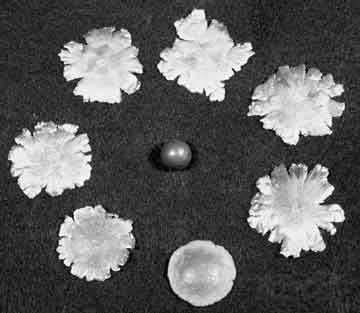
New info about old guns
Except for one thing–airgun maker Gary Barnes has conducted tests showing that round lead balls deform along rigid lines until the ball is completely fragmented by the force of impact. Here’s the big news: this phenomenon happens irrespective of caliber! His claim is that all lead balls deform in more or less the same fashion when they impact a rigid steel plate at a given velocity. A .350 caliber ball impacting a steel plate at 350 f.p.s. will look the same as a .535 caliber ball going the same speed, except for the difference in size. Thus is born the science of “splatology,” or the study of lead “splats” to determine the impact velocity of the ball that created them.
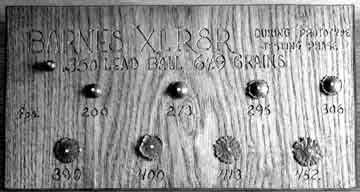
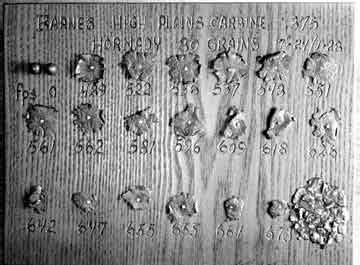
Barnes noticed this relationship very early in the testing of his first big bore guns. The phenomenon was so intriguing to him that he made up “splat boards” containing a spectrum of lead balls that had impacted at different velocities. These he mounted in series, ranging from lowest velocity to highest. The velocities were obtained from an Oehler model 35 chronograph placed in front of the splash plate. He then carved the velocity for each ball into the wood next to the recovered splat. All his splats were produced by a one-inch steel splash plate that stands perpendicular to the flight of the ball, so it’s identical to the plates mentioned in the early airgun documentation.
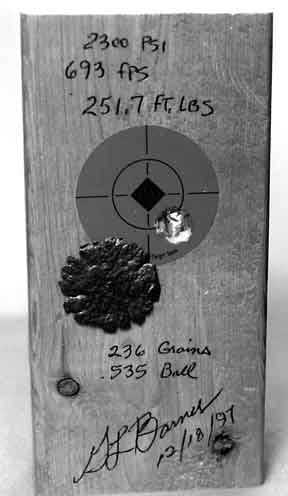
It doesn’t matter when it was shot; a splat tells the same story forever! It’s important to keep in mind the fact that the splats reveal only the velocity upon impact. If the actual muzzle velocity is desired, additional calculation is required. That depends on how far the muzzle was from the impact point. Fortunately, this distance is sometimes given in literature. It’s possible to calculate velocity for tests conducted a century ago, providing the splat is accurately represented (usually by a drawing, but in this century photos were also used) and the distance to the plate is given.
The “splash plate,” as it’s called, must be rigid for the results to be consistent. If not, some of the ball’s energy will be used to move the plate, which results in a splat that looks like it’s going slower. We know the ancients were aware of this phenomenon because it’s mentioned in their notes. In W.H.B. Smith’s book, The Standard Encyclopedia of Gas, Air and Spring Guns of the World, the author mentions that European makers were still testing the power of their modern pellet rifles in 1956 by firing them against steel splash plates.
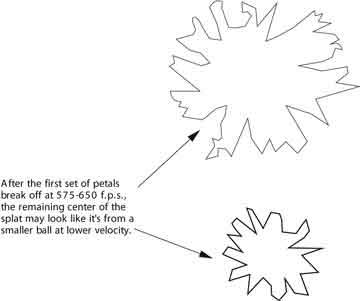
How to calculate velocity without a chronograph
Older English writings state that big bore airgun velocities were gauged by flattening the ball against a steel plate at a specified distance. In the book Air Guns and Air Pistols by L. Wesley, there’s a photograph of flattened balls shot from an air cane, representing the progressive lowering of velocity as the pressure dropped. It’s obvious to anyone who sees the photo that lower velocity results in a ball that is less flattened.
With this technique, it’s possible to examine the older writings about big bore airguns and determine the impact velocity from drawings of recovered balls. Since the steel or iron plate test was a common one when these guns were new, there are several drawings of flattened balls that accompany the guns. Caliber doesn’t matter, remember, since all balls exhibit the same characteristics when they impact a metal plate at the same speed. Here’s an abbreviated version of Barnes’ observations:
At or below 250 f.p.s., the ball will be smashed perfectly flat on the impact side, with the opposite side still round. It will look like a perfect hemisphere, with little of the ball spreading out from the edges of the hemisphere.
At 275 f.p.s., the edge of the ball starts fanning out from the central hemisphere. Barnes calls this “feathering.”
Above 300 f.p.s., the hemisphere that was intact starts to thin out. It’s no longer a true hemisphere.
At 350 f.p.s., the remainder of the ball begins to look like it’s “melting” toward the sides, which are now starting to show signs of separating into both large and small “petals”.
At 400 f.p.s., the ball is nearly flat and separated into distinct petals. Little remains of the original hemisphere.
At 450-480 f.p.s., the ball is completely flat, and the petals are tearing deeper toward the center of the ball.
At 550 f.p.s., the petals are well-formed and very deeply separated. After this point, they start to break off.
At 600 f.p.s., the ball has lost two-thirds of its petals. Now, the center of the ball starts to look like the whole ball did at 450 f.p.s.
At 609-610 f.p.s., a strange thing happens. The center of the ball recoils off the splash plate, and the petals that remain attached to the center recoil back toward the steel plate.
At 650 f.p.s., only the center of the ball remains. Sometimes, it looks like a smaller whole ball, but often there are angular sides and irregular shapes, where major petals were joined. The surface that struck the steel plate is now pointed in the center.
At 675 f.p.s., the center of the ball is smaller. It’s starting to disintegrate into flakes.
Above 700 f.p.s., the center is destroyed; only flakes remain. You can taste vaporized metal in the vicinity of the splash plate.
Test your new splatology skills!
Try your hand at guessing the velocity of the following splats. The featured splats went through the chronograph at recorded speeds. See if you can guess their velocity by comparing them to the splat boards! I’ll publish the actual velocities in tomorrow’s blog.
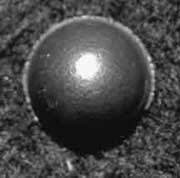
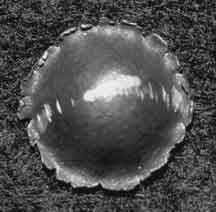

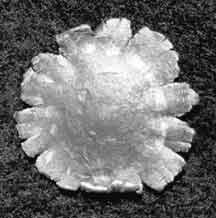
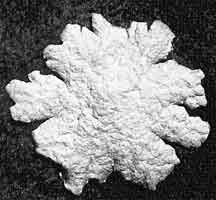
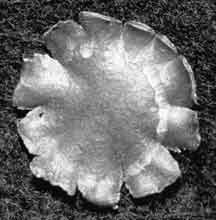
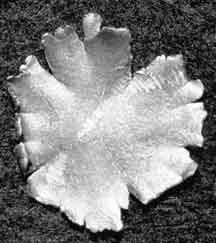
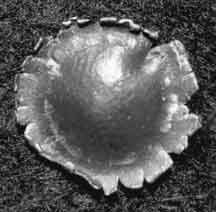

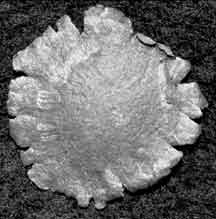
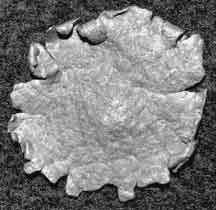
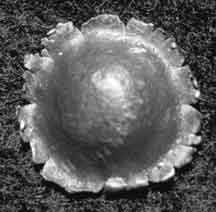
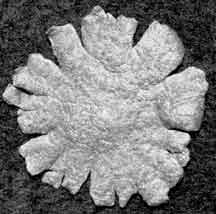

BB,
I'm about ready to order an RWS 52 and a Leapers 3-9X50 scope with the Leapers droop compensating mount. I think I'm suffering from info. overload. While scouring the forums I see the 48/52 has a reputation for killing scopes, Leapers/Centerpoint in particular. The Leapers is airgun rated, but will it hold up to the punishment of the 52 or do I need to do more research?
Thanks,
Knothead
Knothead,
I owned a RWS 54 that also has a reputation for killing scopes and I mounted a leapers 3-12×44. Here's my two cents after alot of brain damage:
1-99% of your potential problems are solved if you use the Leapers droop compensating mount
2-not sure which 3-9x50leapers/centerpoint scope you're considering but would encourage you to choose one of the 5th generation models
3-get a good set of scope rings. steel rings preferably. I used warne rings
kevin
Glug glug glug, sputter, gasp.
Slinging Lead in Powder Springs
Knothead,
Listen to Kevin.
As for the droop compensating scope mount, if you discover your rifle doesn't droop, there is one with no droop, too.
Leapers/Centerpoint scopes are no weaker than any popular scopes, including Burris, Leupold and Bushnell. You have to bear in mind they are being used 20 to 1 over those other scopes because of price, so of course there will be more reports of failure. More Leapers scopes are in use.
B.B.
B.B.
Interesting, but why would anyone use the splat method instead of the ballistic pendulum except for fun?
On the subject of group sizes, I belatedly wondered if someone else had done work on this question and, of course, they had. Here is a page of people using the radial normal distribution with a computer simulation of 100,000 shots.
http://www.the-long-family.com/group_size_analysis.htm
They have a succinct explanation and good graphics including, toward the bottom of the page, a graph of group size versus number of shots which was my original goal.
It looks like I was off a bit. If you scale the vertical axis, it looks like the linear increase does not begin until about 5 shots instead of the 3 that I thought, and it continues well past 20 instead of terminating around shot 17. It also looks like a 3 shot group is a better approximation of larger groups than I had supposed. A 3 shot group is something like .8 of a 5 shot group. So, for those who have ever shot quarter inch 3 shot groups, if you had kept going, maybe, just maybe, you would have pulled down a phenomenal 5 shot group. 🙂
Matt61
Knothead,
I own an RWS 52 and have a Leapers 3-9×40 mil dot AO scope mounted with Weaver rings onto the Leapers compensating base. And it lights up, too, which I've never had reason to use. I've put at least 1,000 rounds down the barrel with no problems to date. If you buy the scope from PA, you should feel confident that the scope is airgun rated. By the way, I used low mounts but if you buy the 50mm objective scope, you will definitely need medium height mounts. Again, PA will help you out here by telling you what exactly to buy. Also, pick up a bottle of Blue Locktite from your friendly, neighborhood autoparts store and apply to all the screws – Leapers compensating mount and rings. The RWS 52 is a great rifle, if a trifle on the heavy side.
Fred
Thanks Kevin and BB for assuring me I had done enough research. I'm sure BB bas answered this question countless times, but thanks for answering it again. I've pretty much read the entire archive of blogs but I just don't have time to read through the comments too. Thanks for making all this information so readily availabe, keep it coming.
Knothead
Hello B.B.,
Thanks for all the wonderful info-following your blog has been an education. I have a quick question-I have a career 707 9mm rifle, and a pump which I bought from Pyramid. I cant get the pump to work; turns out the model I purchased was shipped with fill probes whose o-rings are too small. I've ordered some from pyramid air, and they appear to have been back ordered for at least the last month. Is there anywhere else where I could purchase these o-rings? As it is, I've got a big, pretty, expensive rifle that I get almost no use out of.
Thanks for your time B.B.!
-Christopher
BB,
Let me add my voice to those asking for a review of the new Norica Goliath 88. You can love or hate the "bullpup" look, but the power, if as advertised, would be great in such a small package.
paul
Christopher,
Have you tried cocking your rifle before pumping? The 909 is one that holds the exhaust valve open if there is no air in the reservoir to hold it shut. This only happens when the gun is completely empty, which it never will be again.
Another trick we sometimes do is shoot a shot of CO2 into the rifle to close the valve. Then fill with air the rest of the way and never let it go empty again. Of course you will need the right adaptors to do that.
Assuming you know this and are doing it (cocking the rifle before pumping), then I would take your o-rings to a dive shop or a good hardware store and look for some just a little fatter.
B.B.
Paul,
Okay, I'll start the Goliath next week.
B.B.
Matt,
RE: http://www.the-long-family.com/group_size_analysis.htm
(1) This is the html version of the pdf file I pointed to yesterday.
I am truly sorry I delayed so long in posting the link. It took me a long time to figure out if Figure 7, and Table 1 were correct, and what the data meant.
I'm now convinced that the numbers are right, but I can't figure out what the underlying distribution is. It certainly isn't the normal distribution. I've been wondering if it is the Chi distribution.
(2) Figure 7, and Table 1, are scaled assuming that your shooting is truly 1 MOA. (i.e. God tells you so…)
Figure 7 also shows that the more shots you shoot in a group, then bigger the group size will get. The increase will occur more and more slowly, but group size does keep increasing forever.
Kindest regards,
Herb
BB; I would almost bet there is someone out there that has rebuilt one of the old time air rifles and tested it. Some people will shoot most anything no matter how much it is worth.
Perhaps they are reading this!
Mike
Mike,
Hundreds of old rifles have been rebuilt and tested. We know very well how they perform. But this article was written at a time before we knew that.
Happily, the predictions we were able to make from Spaltology and from testing copies of vintage hand pumps turned out to be right on the money when the old guns were tested.
B.B.
BB,
Splatology is a pretty cool tool — much more interesting than a chronograph to me:). My problem with chronographs is that for some they are almost permanent appendages, and really a sign of how little we actually shoot rifles any more. I know one person who shoots benchrest well enough to need a chrony on his reloads; I don't know anyone that shoots that well offhand or from any of the non-benched positions for that matter. Add to that the endless chrony strings that foul posts on airgun forums, and I'm ready to chuck them in the trash:).
BB, as this post was again about bullets, I felt that it is an appropriate time to ask this question.
I've been thinking about buying some .177 lead BBS recently, just to rey something different…but I'm unsure if they'll work in my current guns. Nothing special: Crosman 760, Daisy 880, and a Crosman 1337. The former two can use steel BBs and pellets, while the later is pellet only. Will the lead BBs work in those guns? I know that the steel BBs are slightly undersized, and rely on a magnet to keep them in the barrel until they're fired, but are lead BBS made the same way?
Thanks as always,
sean
Sean,
I've shot 0.177 lead balls in both the Crosman 760 and Daisy 880. From 10 meters, you need a BIG target. As BB would say, you don't shoot groups, it is more like shotgun patterns. 😉
Lead is not magnetic, so the magnetized probe will not work. The lead balls will NOT feed like BBs. You must load the balls one at a time like you would pellets.
The lead balls will not damage the rifling like steel BBs are reported to do. The steel BBs are undersized because the steel BB is so hard that it cannot conform to the rifling. So the steel BB has to be smaller just to get through the barrel.
The lead balls were fun to play with. It sure made me appreciate how much the diabolo pellet shape helps.
Experiment! Have fun…
BB,
Great one! I wonder whether the results would be the same with pellets? And why don't you mentioned the balistic pendulum on estimating the velocity without chrono?
Got to believe we have all done splatology. I was shocked at the splat of my Disco… of couse my other airguns are much lower power.
Luke,
I will write about the ballistic pendulum sometime soon.
B.B.
I am glad we have chronographs now! Much more accurate and easier.